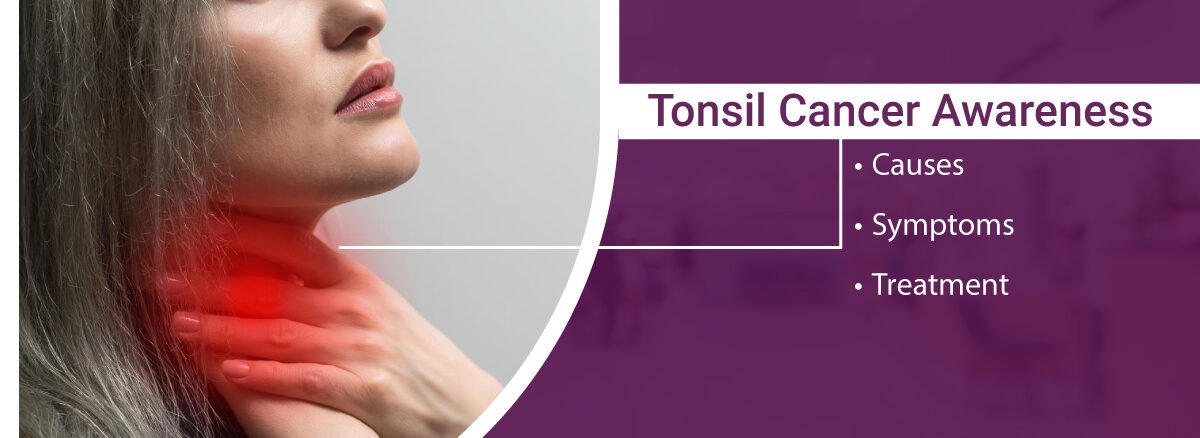Tonsil cancer, a significant type of oropharyngeal cancer, is becoming increasingly prevalent and warrants heightened awareness. This comprehensive blog aims to thoroughly explore various facets of tonsil cancer, including its causes, symptoms, diagnostic procedures, treatment options, and preventive measures. By understanding these critical aspects, particularly signs of tonsil cancer, individuals can be better equipped to recognize early signs and seek timely medical intervention.
Understanding Tonsil Cancer
Overview
- Tonsil cancer originates from abnormal cell growth in the tonsils, part of the immune system.
- Recognized as the predominant form of oropharyngeal cancer.
- Risk persists even after tonsil removal due to residual tissue, underscoring the importance of awareness of signs of tonsil cancer.
Who is at Risk?
- Primarily affects individuals over 50 but can develop at any age.
- Males are 3-4 times more susceptible than females.
- A higher incidence was observed in white populations compared to Black populations.
Prevalence and HPV Connection
- Males face a 1 in 60 lifetime risk; females, a 1 in 140 risk.
- A notable increase in cases due to HPV, heightens the need for recognition of signs of tonsil cancer.
Additional Insights
- Tonsils are part of the body’s defense system against pathogens.
- Tonsil cancer’s link to HPV leads to an increased incidence in younger populations, emphasizing early detection of signs of tonsil cancer.
Tonsil Cancer vs Cysts
Key Differences
- Tonsil cancer involves solid tumor growth, unlike benign fluid-filled cysts.
- Similar symptoms to tonsil cysts highlight the need to distinguish signs of tonsil cancer for correct diagnosis and treatment.
Symptoms and Causes
Recognizing the Signs of Tonsil Cancer
- Symptoms are often subtle initially and can escalate to noticeable tonsil cancer symptoms like persistent neck lumps, mouth sores, and bloody saliva.
- Asymmetrical tonsils and persistent sore throats are common indicators.
- Difficulty swallowing, speaking, or chewing, along with bad breath, are often reported signs of tonsil cancer.
Sensations and Discomfort
- Common sensations include feeling something stuck in the throat.
- Discomfort extending to the ears and mouth varies among individuals, making awareness of signs of tonsil cancer crucial.
Causes of tonsil cancer
- DNA mutations in healthy cells lead to cancerous growth.
- HPV’s significant role, especially in younger patients, necessitates awareness of signs of tonsil cancer.
- Traditional risk factors include tobacco, alcohol use, and weakened immune systems.
Diagnosis and Tests
Initial Assessment
- Comprehensive physical examination, including looking for signs of tonsil cancer, to evaluate tumor size and spread.
- Doctors may spot lesions resembling sores, one of the signs of tonsil cancer.
Diagnostic Procedures
- Advanced imaging tests like CT, PET scans, and MRI assess cancer’s extent.
- Biopsy procedures are definitive for diagnosing signs of tonsil cancer.
- Blood tests, while not diagnostic, help evaluate overall health before treatment.
Management and Treatment
Treatment Options of tonsil cancer
- Transoral robotic surgery (TORS) for early-stage cancers.
- Radiation therapy targets cancer cells, often used when signs of tonsil cancer are detected early.
- Chemotherapy, typically combined with radiation, is used for advanced cases.
- Surgical interventions, including neck dissections, are considered for advanced or persistent cancer.
Managing Side Effects of Radiation Therapy
- Radiation can lead to acute side effects impacting quality of life, making management strategies critical for those showing signs of tonsil cancer.
Recovery Perspectives
- Recovery duration varies, depending on treatment intensity and individual health.
- Patients undergoing TORS generally experience quicker recovery, a positive aspect for those with early signs of tonsil cancer.
Prevention
Risk Reduction Strategies
- Smoking cessation significantly lowers risk.
- HPV prevention through vaccination is crucial, especially for those at risk of developing signs of tonsil cancer.
- Regular oral cancer screenings facilitate early detection of signs of tonsil cancer.
Outlook / Prognosis
Living with Tonsil Cancer
- Collaboration with healthcare professionals for personalized treatment plans.
- Early-stage cancers, especially HPV-related, have high survival rates.
- The prognosis depends on multiple factors, including early detection of signs of tonsil cancer.
Tonsil Cancer Mortality
- Generally, tonsil cancer is not fatal if detected early through recognition of signs of tonsil cancer.
- Survival rates are favorable, particularly for HPV-related cases, but vary based on individual circumstances.
Living With Tonsil Cancer
When to Seek Medical Attention
- Persistent or worsening symptoms warrant immediate medical consultation, particularly if they align with signs of tonsil cancer.
- During treatment, report any new or concerning symptoms to your healthcare provider promptly.
Important Questions for Your Doctor
- Discuss the extent of cancer spread, treatment options, and potential impacts on daily life and work.
- Inquire about the expected duration of treatment and support resources available.
Conclusion
In essence, early recognition of the signs of tonsil cancer is key to effective management and treatment. Awareness, regular screenings, and understanding risk factors are essential. Dr. Simple Bhadania of ACE ENT Clinic underscores the importance of timely medical intervention for optimal outcomes. She is the Best ENT Specialist in Ahmedabad. Stay informed, stay vigilant, and prioritize your throat health.


